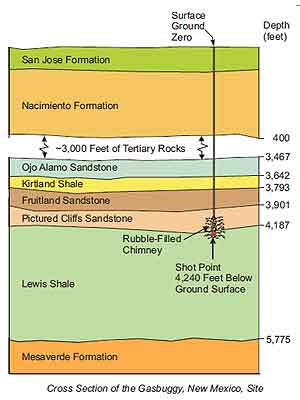Oil and gas fracking is big business in America, with more than two million hydraulically fractured wells across the country producing 43 and 67 per cent of our national oil and gas outputs, respectively. These wells also nearly played a secondary role as nuclear waste storage sites, had the Atomic Energy Commission had its way with Project Plowshare.
Hydraulic fracturing (or “fracking”) is the process of pumping water deep into the Earth, specifically into underground oil and gas reserves, at tremendous pressures in order to break apart the surrounding rock and free the energy product, which can then be pumped out and used.
However in the mid 1950s, scientists from the Atomic Energy Commission and officials from the US Bureau of Mines began experimenting with an alternative method of fracking, one that employed nuclear bombs more powerful than anything we dropped on the Japanese.
Dubbed Project Plowshare, this insane undertaking explored two industrialized — or “peaceful” — applications for nuclear explosives:
Conceptually, industrial applications resulting from the use of nuclear explosives could be divided into two broad categories: 1) large-scale excavation and quarrying, where the energy from the explosion was used to break up and/or move rock; and 2) underground engineering, where the energy released from deeply buried nuclear explosives increased the permeability and porosity of the rock by massive breaking and fracturing.
In 1967, the AEC teamed up with the US Bureau of Mines and El Paso Natural Gas Company for what would be the first of a series of underground experiments. In a remote gas well outside of Farmington, New Mexico, researchers lowered the 29-kiloton “Gasbuggy” nuclear device 1200 metres into the Earth and set it off. The results were spectacular.
“The 4042-foot-deep detonation created a molten glass-lined cavern about 160 feet in diameter and 333 feet tall,” according to the American Oil and Gas Historical Society. “It collapsed within seconds. Subsequent measurements indicated fractures extended more than 200 feet in all directions — and significantly increased natural gas production.”

This initial success led to numerous additional tests in the following years — 27 experiments and 35 nuclear explosions in total. While most of the experiments were small, above-ground explosions were detonated in Nevada with the goal of forming craters and canals. Indeed, two additional underground tests in ’69 and ’73 proved even more massive than Gasbuggy.
In 1969, for example, at a gas well outside of Rulison, Colorado, the AEC set off a 43-kiloton nuclear bomb in an 2590m deep well — but that was nothing compared to the Rio Blanco test in which a trio of 3-kiloton bombs exploded at depths of 1780m, 1900m, and 2040m in a single well near Rifle, Colorado, in 1973.
Rio Blanco would prove to be the final Plowshare experiment as public opposition, environmental concerns, and the successful development of hydraulic fracturing all dissuaded any continuing efforts. Per the Department of Energy’s Office of Scientific and Technical Information:
Although the technology was demonstrated to be technically feasible, it could not be proved that national energy needs justified the elaborate procedures that would be required. Concerns about the potential of the tritium contamination of the gas that would result from nuclear explosive stimulation were raised by Colorado and western alliance agencies. These concerns and the lack of public support for the program made it unlikely that Congress would ever approve a commercial joint government-industry venture.
By 1974, approximately 82 million dollars had been invested in the nuclear gas stimulation technology program …. It was estimated that even after 25 years of gas production of all the natural gas deemed recoverable, that only 15 to 40 per cent of the investment could be recovered. At the same time, alternative, non-nuclear technologies were being developed, such as hydrofracturing. Consequently, under the pressure of economic and environmental concerns, the Plowshare Program was discontinued at the end of FY 1975.
While all three sites remain under the watch of the DOE’s Office of Legacy Management (which handles the cleanup of Superfund sites), a 2004 cleanup effort at the Gasbuggy site made a surprising discovery.
Crews found that “liquid radioactive waste was injected into the cavity formed by the nuclear explosion; solid radioactive waste was removed to the Nevada Test Site,” according to the DOE.

The same appears to be true at both Colorado sites, as well. They are routinely tested by both the DOE and the EPA to ensure radioactive material isn’t leeching into ground water supplies and all tests so far have concluded that the nuclear materials are staying in place.
However, given the environmental issues cropping up with current hydraulic fracking — such as flammable tap water — nuclear fracking might be poised to make a comeback. According to a study presented at last year’s annual meeting of the American Geophysical Union by Leonid Germanovich, a physicist and civil and environmental engineer at the Georgia Institute of Technology, liquid nuclear waste could be used as the fracking fluid instead of water.
Since nuclear waste is more dense than the rock it’d be injected into, the radioactive slurry would never rise back to the Earth’s surface and thus — in theory — would never contaminate the water table. “It’s basic physics here — if it’s heavier than rock, the fracture will propagate down,” Germanovich explained at the conference. Instead, he hypothesizes, it would continue to traverse further into the crust, providing a means of energy production and nuclear waste management in one. In his eyes, it’s a win-win. [Forbes — Live Science — Wiki — AOGHS 1, 2]
